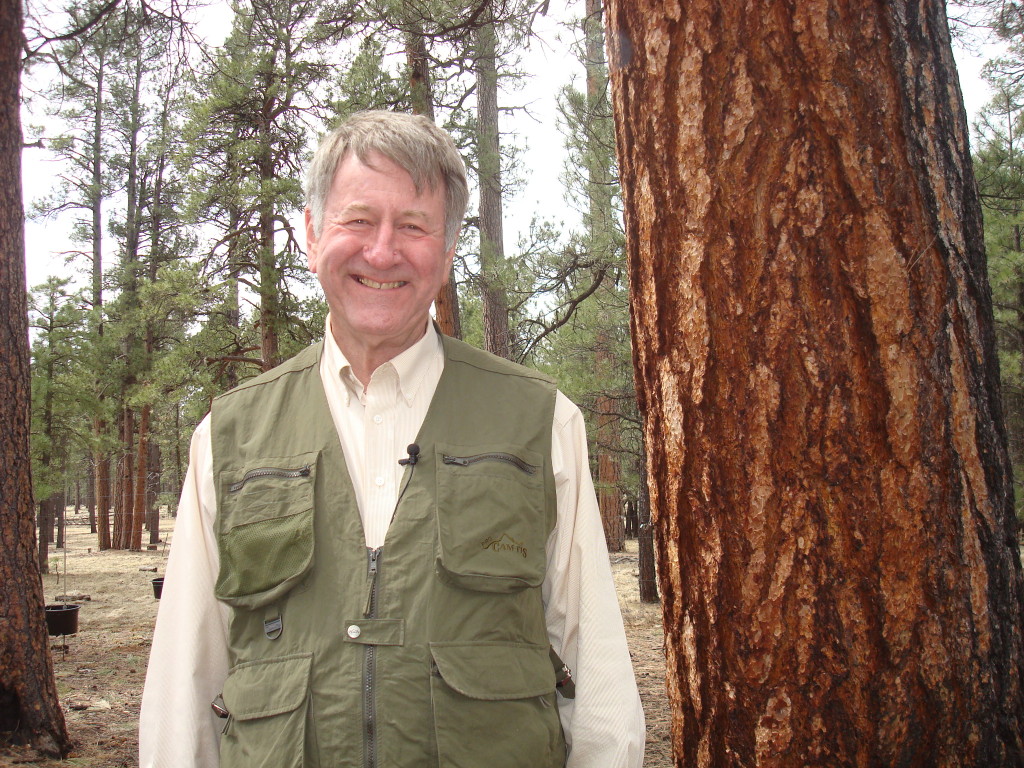Over four decades of study, forestry professor and restoration ecologist Wally Covington has seen trees compete for water and sunlight, struggle with insects and disease, turn to ash in wildfires. He has also seen the future in the past—what a forest should look like through what it used to look like.
Covington this week was recognized with the Biswell Lifetime Achievement Award from the Association of Fire Ecology, honoring his pioneering research in dry, frequent-fire forests of the West.
More than 100 years ago forests of the Southwest were open and park-like, dominated by groups of large, towering ponderosa pines and filled with a diversity of grasses and wildflowers. Today, they are dense and dark, overcrowded with dog-hair thickets of small-diameter trees. They are plagued by wildfires and a lack of plant and animal diversity.
When Covington first arrived in Flagstaff in 1975, he set out to heal sick forests. He had just emerged from the doctoral forestry program at Yale University and joined Northern Arizona University as an assistant professor of forestry.
|
“It was always my dream to be at NAU,” Covington said. “The School of Forestry program was broad enough that I had the freedom to work with colleagues to solve complex problems and implement research aimed at restoring the self-regulatory mechanisms of the ecosystem.”
Covington began his college pursuits studying human medicine. But after taking a few ecology courses, he discovered that forest ecosystems were the patients most in need of his care. He noticed that healthy ecosystems, like the human body, can better resist and recover from illnesses. His appointment at NAU would prove the perfect place to practice his brand of forest medicine.
“For the first six years, my colleagues and I focused on developing controlled burning prescriptions to reduce surface fuels and thin out excess young trees,” he said. “But the results were discouraging, and even alarming when on several of the burns, fires climbed into the tree tops and threatened to escape.”
Covington discovered there were too many small, young trees crowding the old, large trees to safely use controlled burning alone. This led him to develop a more comprehensive approach, one based on ecological restoration principles.
He and his colleagues wanted to know what the forest looked like before Euro-American settlers arrived. Evidences like old stumps and fire scars revealed that ponderosa pine forests were more open and park-like and had evolved with frequent surface fires. Covington’s research team then constructed a set of controlled experiments that mechanically thinned post-settlement trees while protecting old-growth trees, and then introduced surface fire.
“The results of these restoration experiments were stunning,” Covington said. “Old-growth trees began growing like teenagers. Grasses and wildflowers burst forth with a startling abundance of production and flowering. In turn, butterflies and songbirds increased in numbers, and snow pack and soil moisture improved.”
Restoration-based treatments like those pioneered by Covington are used by land managers today on a scale Covington never could have imagined in his early days at NAU. Restoration projects that were just a few acres in size are now planned at the scale of millions, like the Four Forest Restoration Initiative, or 4FRI.
“In the face of global climate change, the best hope for those of us in fire-prone dry forests is to continue to work together to restore ecosystems to more natural conditions so they can cope with whatever changes are likely to come their way.”



